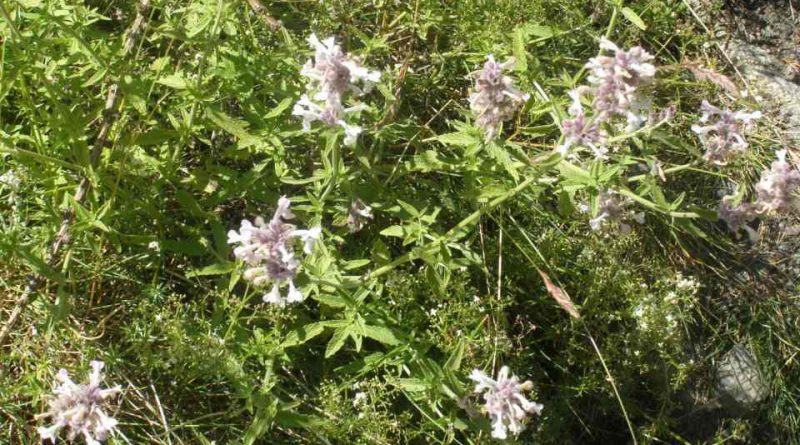Nepeta nepetella
Nepeta nepetella
The lesser cat-mint (Nepeta nepetella L., 1759) is a small perennial herbaceous aromatic species of the Lamiaceae family.
Systematics –
From the systematic point of view it belongs to the Eukaryota Domain, Reign Plantae, Sub-Trinchebionta Subdivision, Spermatophyta Superdivision, Magnoliophyta Division, Magnoliopsida Class, Asteridae Subclass, Lamiales Order, Lamiaceae Family, Mentheae Tribe and then to the Genus Nepeta and the Species N. nepetella.
Etymology –
The term Nepeta is found for the first time in writings by Gaius Pliny the Second, perhaps because it came from Nepi, in Etruria. The specific epithet nepetella is the diminutive from the genus Nepeta, as it is literally “small nepeta” due to the smaller size of the plant.
Geographical Distribution and Habitat –
The lesser cat-mint is a plant of Mediterranean European origins, not very widespread spontaneously both in Italy where it can be found in the north-east and in the center. It is present in the Alpine area only in the west and in other European mountains connected to the Alps it is located in the Pyrenees.
Its habitat is that of the uncultivated, the ruins, old walls, shady meadows, dry meadows and pastures, with an elevation from the hill to the subalpine level, therefore between 800 and 2200 m. s.l.m ..
It grows preferably on calcareous or calcareous / siliceous soils with neutral pH values, and on substrates with low nutritional and dry values.
Description –
The Nepeta nepetella is a perennial plant suffruticosa, tomentosa, with grayish coloring. The stems are erect pubescent or tomentous, woody at the base and with quadrangular section. It reaches heights between 30 and 80 cm, with roots are secondary to rhizome.
The leaves are briefly petiolate, pubescent or tomentose, opposite, rounded or heart-shaped at the base, with elliptic lamina – lanceolate and edges whose sides are 5 – 6 deep teeth with acute apex.
The flowers, hermaphrodite, zygomorphic, whitish or rose-violet in color, are gathered in ramose inflorescence, formed by verticillastri 4-6 floras, which form a spicastro, provided with bracts and bracts.
The fruit is a tetrachenium (composed of four nuculas) enclosed in a persistent calyx. The shape is ovoid trigona (dimensions 1.7 x 1 mm). The seeds have no endosperm.
Cultivation –
For the multiplication of this plant very similar techniques are valid for the other mind and it is recalled that it is easily multiplied by division of the tufts and that it prefers calcareous or calcareous-siliceous soils with a neutral pH.
For the fertilization it is possible to intervene from the vegetative restart starting from March until November with fertilizer for flowering plants, liquid or granular, at least once every 30 days, or only at the beginning with a discreet supply of well humified organic substance.
For irrigation, if the plant is cultivated in the open ground, it is necessary to irrigate occasionally during the vegetative months, from around April to October. If the plant is in pot, wet it regularly from March to October.
For pruning it is necessary to regularly remove withered flowers, unless you want to collect the seeds. At the end of the vegetative cycle, in autumn, cut the aerial part that is drying and which will return in the spring. The operation can be delayed if the autumn foliage or withered inflorescences have an ornamental value.
Uses and Traditions –
The lesser cat-mint is a plant used for both leaves and flowers. The leaves and flowers have sedative, antiseptic and antispasmodic properties.
The leaves must be harvested at the beginning of flowering, and they must be dried in a shady and ventilated place, keeping them away from light and dry conditions.
The leaves of Nepeta nepetella have a very penetrating aroma and are used in gastronomy to flavor fish dishes, shellfish, mushrooms and grilled meats.
The essential oil present in all parts of the plant has an aroma similar to that of mint; it is used in cosmetics and for the high content of geraniol, limonene and cytronelalin in repellents against mosquitoes and flies.
It should be remembered that the essential oil obtained through the steam distillation of flowers and leaves, also contains nepetalactone, a psychoactive principle which is responsible for the attraction effect of felines, of which excites the nervous system favoring the oestrus .
Preparation Mode –
The leaves of this plant are used in the kitchen to give flavor to meat, fish and mushroom dishes. Furthermore the essential oil, as mentioned, has many applications in cosmetics and in repellent products for some insects.
Guido Bissanti
Sources
– Acta Plantarum – Flora of the Italian Regions.
– Wikipedia, the free encyclopedia.
– Treben M., 2000. Health from the Pharmacy of the Lord, Advice and experiences with medicinal herbs, Ennsthaler Editore
– Pignatti S., 1982. Flora of Italy, Edagricole, Bologna.
– Conti F., Abbate G., Alessandrini A., Blasi C. (edited by), 2005. An annotated checklist of the Italian vascular flora, Palombi Editore.
Attention: Pharmaceutical applications and food uses are indicated for informational purposes only, do not in any way represent a medical prescription; therefore no responsibility is assumed for their use for curative, aesthetic or food purposes.


